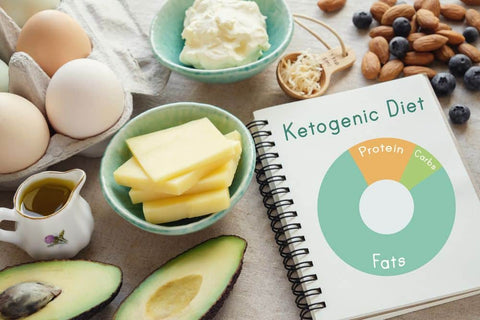Meats:
Opt for grass-fed meats that are free of hormones and antibiotics. Popular choices include lamb, bacon (nitrite-free and carb-free), beef, duck, turkey, chicken, and pork. Make sure the sausages contain only meat and spices, no sugar or gluten.Fish and seafood:
Favor wild fish and seafood to avoid overconsumption of omega-6. Common options include crab, shrimp, salmon, tuna, and trout.Eggs:
Free-range organic eggs are a great choice for the keto diet. They are versatile and can be consumed at any time of the day.Fat:
Include healthy fats like butter, avocado oil, coconut oil, extra virgin olive oil, and ghee (clarified butter) in your diet.Dairy products:
Always choose high-fat dairy products, such as butter, 35% cream, and various cheeses.Vegetables:
Low-carb vegetables are essential on the keto diet. Include asparagus, broccoli, spinach, lettuce, avocado, and zucchini in your keto food list.Fruits:
Although most fruits are high in carbohydrates, some, such as berries (strawberries, raspberries, blackberries) and lemon, can be eaten in moderation.Nuts and seeds:
Almonds, macadamia nuts, chia seeds, and flax seeds are excellent sources of fat and protein.Beverages:
Water, teas, herbal teas, and coffee (with cream or butter) are the best beverage choices for the keto diet.To consume with moderation:
Certain foods and drinks, such as alcohol and sweets, can be consumed occasionally, but with caution.The benefits of the ketogenic diet:
The ketogenic diet is not just about weight loss. It also offers other health benefits, such as improving brain function, reducing inflammation, and stabilizing blood sugar levels. Additionally, some studies suggest that the keto diet may help combat certain chronic illnesses like type 2 diabetes and certain forms of epilepsy.Common mistakes to avoid:
When you start the keto food list, it is easy to make mistakes. Some of the most common include eating too much protein, neglecting electrolytes, and not eating enough fats. It's also essential to make sure you drink enough water to stay hydrated.
How to deal with early side effects:
When you start the keto food list, you might experience what's called the "ketogenic flu." This may include symptoms such as headache, fatigue, and dizziness. To mitigate these effects, make sure you're getting enough electrolytes, stay hydrated, and consider a more gradual transition to the diet.
Keto Recipes and Meal Ideas:
To maintain the ketogenic diet for the long term, it is essential to have a variety of delicious recipes on hand. Think of dishes like cheesy cauliflower gratin, zucchini lasagna, or even almond and raspberry muffins. Don't forget snacks, such as almond butter energy balls or kale chips.
Ketogenic Diet FAQs
1. How long after starting to eat ketogenic foods does it take to get into ketosis?
Answer: After incorporating a strict keto food list into your diet, most people enter ketosis within 2 to 4 days. However, this can vary and take up to a week or more for some.
2. When following the keto diet what to eat, how do I know if I'm in ketosis?
Answer: When you're following the diet and consuming primarily keto-friendly foods, there are several signs that you may be in ketosis, such as metallic breath or an increased feeling of fullness. For confirmation, urine test strips or blood ketone monitors can be used.
3. Following the keto food list, is it possible to consume too much fat?
Answer: Although the keto diet what to eat focuses on high fat consumption, it is possible to consume too much. It is essential to listen to your body and eat until full, making sure to balance your “keto food” intake.
Conclusion:
Mastering the ketogenic diet requires a thorough understanding of which foods to prioritize and which to avoid. With this list of allowed foods, you are well equipped to start your keto journey successfully.

